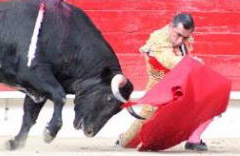Everyone Wins In Tijuana Opener

Tijuana taurina has languished at the edge of the abyss for more than twenty years. Poor, disinterested management, lack of a marketable Mexican figura, the national economic crisis, local narco-violence and border crossing issues conspired to leave the formerly thriving “Monumental de Las Playas” on life support.
That may be about to change. A new empresarial group, Casa Toreros, of Jalisco, Mexico, has undertaken the considerable task of reinvigorating the once majestic ring. A newcomer to the Mexican taurine management scene, Casa Toreros has already begun to build a business model based on presenting the best matadors in Mexico and Spain, facing the best bulls available from a struggling national market of brave stock. Their relative youth and enthusiasm for the Fiesta is expertly communicated in state of the technological art publicity, which informs the entire taurine world of the events the group offers. If the inaugural corrida of 2013 temporada, celebrated Sunday, May 12, is a harbinger of things to come, aficionados de los toros from both sides of the border could have a lot to cheer about.
The original card included the Spanish master, Julian Lopez, “El Juli”, alongside the reinvigorated craftsmanship of the sturdy 27 year veteran Eulalio Lopez “Zotoluco”, and the resurrected promise of Octavio Garcia, “El Payo”. When “Juli” was seriously gored during the second of his 3 scheduled appearances in Spring Fair in Sevilla, Spain, Casa Toreros immediately stanched the potential economic disaster by contracting Juan Pablo Sanchez, one of the most promising among a bumper crop of young Mexican toreros that are turning heads all over the taurine world.
A diverse, bull-savvy crowd showed up on the sun-splashed Mother’s Day to fill a bit less than half the plaza for what turned out to be one of the most satisfying afternoons in recent memory.
The bulls, from the La Estancia ranch of the state of Guanajuato, were as well presented as Mexican bulls can be in this era of diluted blood lines, and of the six, only 1, the 3rd of the afternoon, offered any serious difficulties. The remaining 5 were—in differing shades—matices—noble and generous in their attacks, and two, the bulls run in 2nd and 4th place, were excellent. This handsome fourth bull, baptized with the name of “Borreguero” was so noble and frank in his charges, and fought for so long, growing better as the encounter with Zotoluco, his matador, lasted, that the public demanded his life be spared.
Zotoluco is no one’s idea of a figura de epoca-an epoch making star; he has endured by his professionalism and willingness to compete with anyone, anytime, with any bulls. His technique is probably underrated, but in his “life after non-retirement”, he has achieved an artistic purity which may surprise even himself. He had the great fortune of drawing the two best bulls of the afternoon, and extracted everything they had in two honest, elegant faenas performed with the enthusiasm and determination of a hungry newcomer. Both lidias began with faroles from his knees, and the maestro began the faena to “Borreguero” by challenging the bull from his knees in the center of the ring. A well deserved ear was cut from his first bull, and although the pardoning of the life of “Borreguero” raised the expected polemic (his physical conformation left something to be desired, and though his nobility and frank, rhythmic attacks were profound and long-lasting, he lacked that certain spark of nerve or spirit that marks a truly brave bull), Zotoluco was nearly perfect. An impressive statement from the veteran.
One year ago, the career of Octavio Garcia, “El Payo” was widely considered to be finished. A disastrous performance in the San Isidro fair in Madrid—where reputations, and the contracts they bring—are made and lost, Payo lost, big. Few, perhaps even the young matador himself, thought it likely that he would ever recover.
After a period of reflection, however, Payo began the long road to recover his professional dignity. Strong performances in Plaza Mexico, Queretaro, and Juriquilla, Mexico, over the winter, and a jaw-dropping demonstration of cojones in the recently terminated Feria de San Marcos of Aguascalientes, left little doubt that Payo is completely resurrected. His actions Sunday, with two bulls of completely different conditions, show that his talent and capacity are deep and fully in his control. Better luck with the sword would have earned Payo at least two, perhaps three, ears.
Juan Pablo Sanchez, grandson, son, and nephew of a proud, if humble, line of toreros, drew the least cooperative bulls of the afternoon, but managed to make the most of them, especially “Bengala”, run in sixth place. His renowned sense of temple—the ability to impose slowness on the bull’s attacks and thus prolong both the beauty—and danger—of the pass, was on full display. The bull was rather weak and had to be carefully handled, which Sanchez did perfectly. Only another muffed sword thrust separated Sanchez from at least one ear, perhaps two.
A more promising beginning to Casa Torero’s adventure with the Plaza Monumental de Las Playas probably couldn’t have been written. It’s only one corrida, but a very successful one, well attended—given Tijuana’s recent history—and more celebratory and “event-like” (even the “antis” were out before the corrida, ironically, perhaps the most telling testimony to the potential success of Casa Toreros) than a corrida in Tijuana has been in many years. Let’s hope the success continues.






